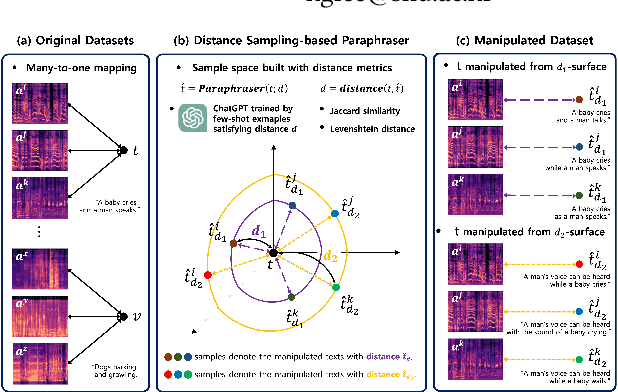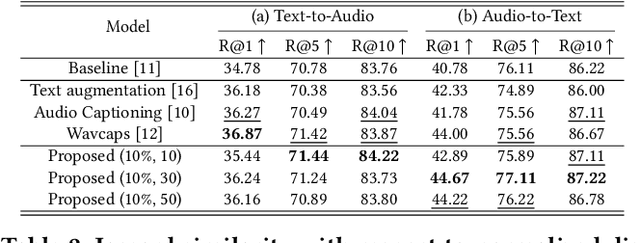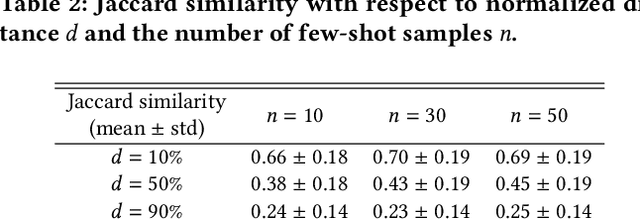Yoori Oh
Hear Your Face: Face-based voice conversion with F0 estimation
Aug 19, 2024



Abstract:This paper delves into the emerging field of face-based voice conversion, leveraging the unique relationship between an individual's facial features and their vocal characteristics. We present a novel face-based voice conversion framework that particularly utilizes the average fundamental frequency of the target speaker, derived solely from their facial images. Through extensive analysis, our framework demonstrates superior speech generation quality and the ability to align facial features with voice characteristics, including tracking of the target speaker's fundamental frequency.
Distance Sampling-based Paraphraser Leveraging ChatGPT for Text Data Manipulation
May 01, 2024



Abstract:There has been growing interest in audio-language retrieval research, where the objective is to establish the correlation between audio and text modalities. However, most audio-text paired datasets often lack rich expression of the text data compared to the audio samples. One of the significant challenges facing audio-text datasets is the presence of similar or identical captions despite different audio samples. Therefore, under many-to-one mapping conditions, audio-text datasets lead to poor performance of retrieval tasks. In this paper, we propose a novel approach to tackle the data imbalance problem in audio-language retrieval task. To overcome the limitation, we introduce a method that employs a distance sampling-based paraphraser leveraging ChatGPT, utilizing distance function to generate a controllable distribution of manipulated text data. For a set of sentences with the same context, the distance is used to calculate a degree of manipulation for any two sentences, and ChatGPT's few-shot prompting is performed using a text cluster with a similar distance defined by the Jaccard similarity. Therefore, ChatGPT, when applied to few-shot prompting with text clusters, can adjust the diversity of the manipulated text based on the distance. The proposed approach is shown to significantly enhance performance in audio-text retrieval, outperforming conventional text augmentation techniques.
Continuous Emotional Intensity Controllable Speech Synthesis using Semi-supervised Learning
Nov 11, 2022Abstract:With the rapid development of the speech synthesis system, recent text-to-speech models have reached the level of generating natural speech similar to what humans say. But there still have limitations in terms of expressiveness. In particular, the existing emotional speech synthesis models have shown controllability using interpolated features with scaling parameters in emotional latent space. However, the emotional latent space generated from the existing models is difficult to control the continuous emotional intensity because of the entanglement of features like emotions, speakers, etc. In this paper, we propose a novel method to control the continuous intensity of emotions using semi-supervised learning. The model learns emotions of intermediate intensity using pseudo-labels generated from phoneme-level sequences of speech information. An embedding space built from the proposed model satisfies the uniform grid geometry with an emotional basis. In addition, to improve the naturalness of intermediate emotional speech, a discriminator is applied to the generation of low-level elements like duration, pitch and energy. The experimental results showed that the proposed method was superior in controllability and naturalness. The synthesized speech samples are available at https://tinyurl.com/34zaehh2
Improving Audio-Language Learning with MixGen and Multi-Level Test-Time Augmentation
Oct 31, 2022



Abstract:In this paper, we propose two novel augmentation methods 1) audio-language MixGen (AL-MixGen) and 2) multi-level test-time augmentation (Multi-TTA) for audio-language learning. Inspired by MixGen, which is originally applied to vision-language learning, we introduce an augmentation method for the audio-language domain. We also explore the impact of test-time augmentations and present Multi-TTA which generalizes test-time augmentation over multiple layers of a deep learning model. Incorporating AL-MixGen and Multi-TTA into the baseline achieves 47.5 SPIDEr on audio captioning, which is an +18.2% over the baseline and outperforms the state-of-the-art approach with a 5x smaller model. In audio-text retrieval, the proposed methods surpass the baseline performance as well.
 Add to Chrome
Add to Chrome Add to Firefox
Add to Firefox Add to Edge
Add to Edge